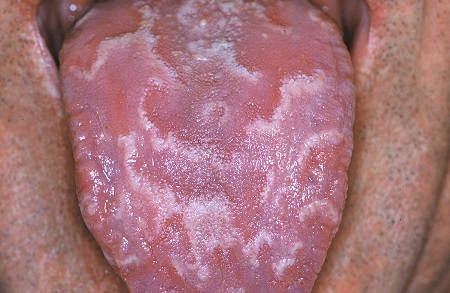Approach
Fissured tongue
The patient is usually asymptomatic. Patients usually have fissured tongue from childhood, but the condition may become more prominent with increasing age.
Physical examination usually reveals multiple grooves or fissures. Occasionally, there may be halitosis and discolouration due to trapped food debris.[22][23][Figure caption and citation for the preceding image starts]: Fissured tongue with grooves or fissures on the dorsal surfaceLmossabasha064 / CC-BY-SA-4.0 (https://creativecommons.org/licenses/by-sa/4.0/deed.en) [Citation ends].
Biopsy is rarely needed due to the characteristic diagnostic clinical appearance.
Hairy tongue
The clinical presentation of hairy tongue is characterised by hair-like projections on the dorsal midline tongue that can vary in colour from yellow to brown-black. The colour variation may depend on the exogenous staining from various foods and beverages.
There may be a history of increased use of tobacco, coffee and tea, poor oral hygiene, and the use of oxidising mouthwashes. Poor oral intake during illness, hyposalivation, or oral discomfort secondary to oral ulcerative conditions are examples of situations where keratin shedding is reduced. These can increase the retention of keratin at the tips of the filiform papillae.
Patients may complain of halitosis and a bad taste and may seek treatment due to the unaesthetic appearance. On examination, the hair-like projections that are usually concentrated in the middle of the tongue denote actual hypertrophy of the filiform papillae.
If a patient is HIV-positive a tongue biopsy may be necessary to differentiate from oral hairy leukoplakia.[24]
Geographic tongue
Geographic tongue is usually a clinical diagnosis with the classic appearance of erythematous patches with scalloped white borders and a central atrophic zone on the dorsal tongue.[Figure caption and citation for the preceding image starts]: Geographic tongue, presenting with typical red areas surrounded by white scalloped bordersDimitrios Malamos/CC BY 4.0 (https://creativecommons.org/licenses/by/4.0/deed.en) [Citation ends]. Historically, patients report that the patches seem to migrate. Patients might experience a burning sensation on the tongue with an increased sensitivity to hot and spicy foods.[3]
Historically, patients report that the patches seem to migrate. Patients might experience a burning sensation on the tongue with an increased sensitivity to hot and spicy foods.[3]
History and physical examination are usually sufficient to diagnose geographic tongue due to its classic clinical appearance.[1] On occasion, geographic tongue may need to be differentiated from localised papillary atrophy of the tongue secondary to anaemia or nutritional deficiencies such as B12 deficiency.
Rarely, similar presentations may occur elsewhere in the mouth, sometimes referred to as geographic stomatitis or ectopic geographic tongue.
Use of this content is subject to our disclaimer